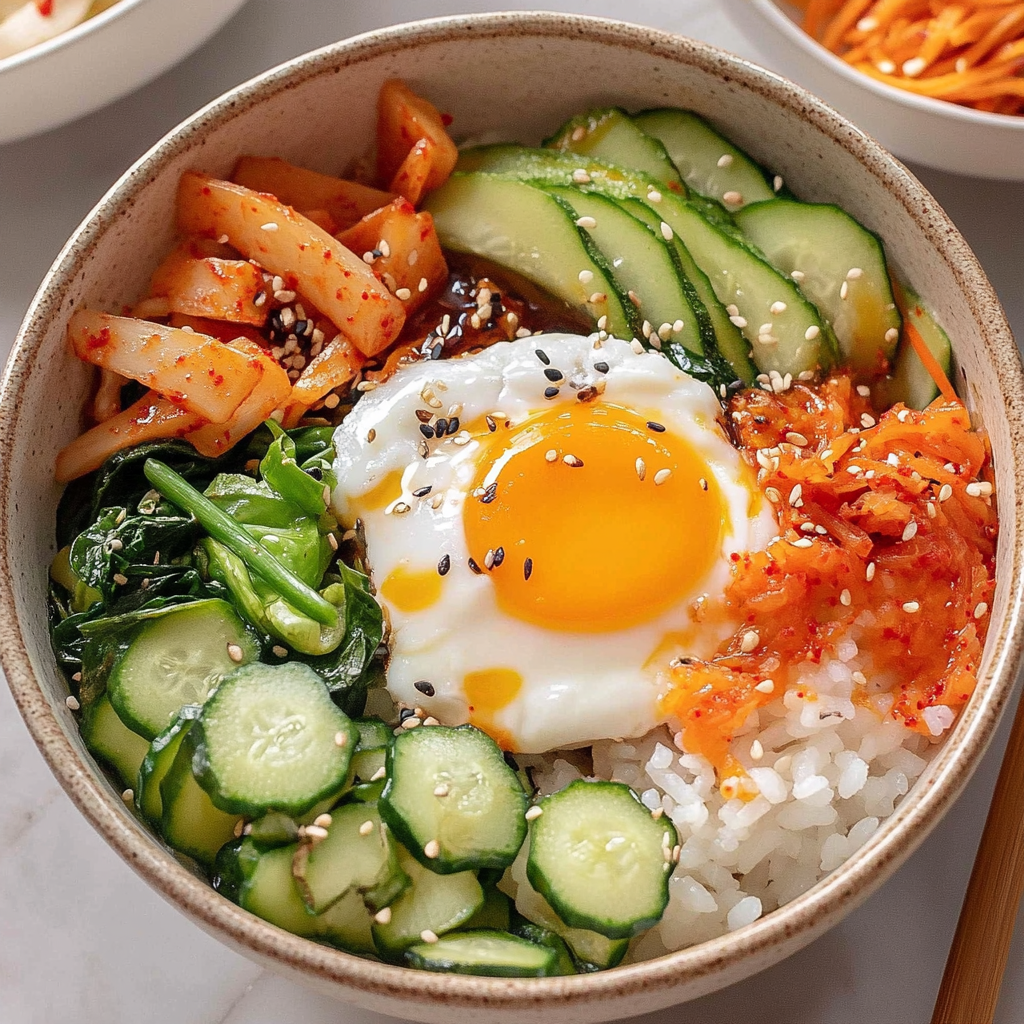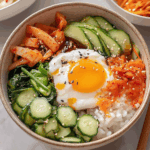Korean Veggie Bibimbap Bowls are vibrant, balanced rice bowls topped with assorted seasoned vegetables, a fried egg or tofu, and a bold, spicy-sweet gochujang sauce. It’s a delicious, customizable dish full of color, texture, and flavor.
Why You’ll Love This Recipe
Bibimbap is more than just a meal—it’s a full sensory experience. You’ll love the combination of savory, spicy, tangy, and nutty flavors with the crunch and freshness of perfectly cooked vegetables. It’s nutrient-dense, naturally gluten-free (with tamari), and easily made vegan. Plus, all the components can be made ahead for quick assembly throughout the week.
Ingredients
(Tip: You’ll find the full list of ingredients and measurements in the recipe card below.)
- Cooked short-grain white rice or brown rice
- Carrots (julienned)
- Zucchini (julienned)
- Shiitake mushrooms (sliced)
- Baby spinach
- Bean sprouts
- Cucumber (thinly sliced)
- Firm tofu or eggs
- Sesame oil
- Soy sauce or tamari
- Garlic (minced)
- Sesame seeds
- Green onions
- Kimchi (optional)
For the Bibimbap Sauce:
- Gochujang (Korean chili paste)
- Sesame oil
- Rice vinegar
- Honey or maple syrup
- Minced garlic
- Water to thin, if needed
Directions

- Cook the rice according to package instructions. Set aside.
- Prepare vegetables:
- Blanch spinach and bean sprouts, then squeeze out excess water and season with a touch of sesame oil, soy sauce, garlic, and sesame seeds.
- Sauté mushrooms with sesame oil and a splash of soy sauce until tender.
- Lightly sauté carrots and zucchini separately until just tender.
- Keep cucumber raw for crunch.
- Prepare the tofu or egg:
- For tofu: press, cube, and pan-fry until golden.
- For egg: fry sunny-side-up with a runny yolk.
- Make the sauce: In a bowl, whisk together gochujang, sesame oil, rice vinegar, honey, garlic, and a little water until smooth.
- Assemble: Divide rice into bowls. Arrange vegetables, tofu or egg, and optional kimchi on top.
- Finish: Drizzle with bibimbap sauce, sprinkle with green onions and sesame seeds. Mix before eating for the best flavor.
Servings and timing
- Serves: 2–4
- Prep time: 20 minutes
- Cook time: 15 minutes
- Total time: 35 minutes
Variations
- Vegan: Use tofu and omit the egg.
- Spicy: Add extra gochujang or chili flakes to the sauce.
- Grain-free: Substitute cauliflower rice or quinoa.
- Meaty version: Add bulgogi beef or grilled chicken.
- No-cook: Use pre-cooked rice and raw or quick-marinated vegetables for a fast meal.
Storage/reheating
- Store components separately in airtight containers for up to 4 days.
- Reheat rice and cooked vegetables in the microwave or skillet; add fresh toppings after reheating.
- Sauce can be stored in the fridge for up to 1 week in a sealed jar.
FAQs
1. What does bibimbap mean?
Bibimbap means “mixed rice” in Korean—everything is stirred together before eating.
2. Is gochujang spicy?
It has a medium heat and is also sweet and savory. You can adjust the amount to your taste.
3. Can I make this gluten-free?
Yes, use tamari instead of soy sauce and a certified gluten-free gochujang.
4. Can I use other vegetables?
Absolutely—bell peppers, radishes, cabbage, or kale all work well.
5. How do I get crispy rice like dolsot bibimbap?
Use a cast iron skillet or stone bowl, press rice down, and cook until a golden crust forms.
6. Can I prep this for meal prep?
Yes, prep all components in advance and assemble bowls as needed.
7. What protein can I use instead of tofu or egg?
Grilled chicken, beef bulgogi, shrimp, or tempeh are great options.
8. What if I don’t like spicy food?
Use less gochujang or swap with a soy-garlic or miso-based sauce.
9. Is bibimbap served hot or cold?
Traditionally warm, but it’s also delicious at room temperature or chilled.
10. What’s a good side dish for bibimbap?
Kimchi, miso soup, or pickled veggies make great side pairings.
Conclusion
Korean Veggie Bibimbap Bowls are healthy, hearty, and full of flavor. This customizable dish is perfect for any dietary preference and makes an excellent make-ahead lunch or quick dinner. With its balance of rice, veggies, protein, and sauce, it’s easy to see why bibimbap is a Korean classic that everyone can enjoy.
PrintKorean Veggie Bibimbap Bowls
Korean Veggie Bibimbap Bowls are a vibrant and healthy dish featuring a medley of sautéed and fresh vegetables over a bed of rice, topped with a fried egg and drizzled with a flavorful homemade gochujang sauce. Perfect for a meatless meal packed with flavor and nutrition.
- Prep Time: 15 minutes
- Cook Time: 15 minutes
- Total Time: 30 minutes
- Yield: 4 servings 1x
- Category: Main Course
- Method: Stovetop
- Cuisine: Korean
- Diet: Vegetarian
Ingredients
- 2 cups cooked white or brown rice
- 1 cup spinach, sautéed
- 1 cup bean sprouts, blanched
- 1 medium carrot, julienned
- 1 zucchini, julienned
- 1 cup shiitake mushrooms, sliced
- 1 tablespoon sesame oil
- 2 teaspoons soy sauce
- 2 cloves garlic, minced
- 4 eggs
- 1 tablespoon vegetable oil
- 1/2 cup kimchi (optional)
- 1 tablespoon sesame seeds (for garnish)
- 2 green onions, sliced (for garnish)
For the Gochujang Sauce:
- 2 tablespoons gochujang (Korean chili paste)
- 1 tablespoon sesame oil
- 1 tablespoon rice vinegar
- 1 tablespoon soy sauce
- 1 tablespoon maple syrup or honey
- 1 teaspoon minced garlic
- 1–2 teaspoons water (to thin as needed)
Instructions
- Prepare all vegetables: sauté spinach with a bit of sesame oil and garlic; blanch bean sprouts; sauté zucchini, carrots, and mushrooms separately with a little sesame oil and soy sauce.
- Mix all sauce ingredients in a bowl and thin with water to desired consistency. Set aside.
- Heat vegetable oil in a non-stick pan over medium heat and fry the eggs until whites are set but yolks remain runny.
- Divide rice among 4 bowls. Arrange prepared vegetables, kimchi (if using), and fried egg on top of the rice.
- Drizzle with gochujang sauce and garnish with sesame seeds and sliced green onions.
- Serve immediately. Stir everything together before eating for best flavor.
Notes
- Use any combination of vegetables you like or have on hand.
- Make it vegan by omitting the egg or using a plant-based alternative.
- Cooked rice can be substituted with cauliflower rice for a low-carb version.
- Adjust the spiciness of the sauce by increasing or decreasing gochujang.
Nutrition
- Serving Size: 1 bowl
- Calories: 430
- Sugar: 6g
- Sodium: 720mg
- Fat: 17g
- Saturated Fat: 4g
- Unsaturated Fat: 12g
- Trans Fat: 0g
- Carbohydrates: 52g
- Fiber: 5g
- Protein: 14g
- Cholesterol: 190mg

